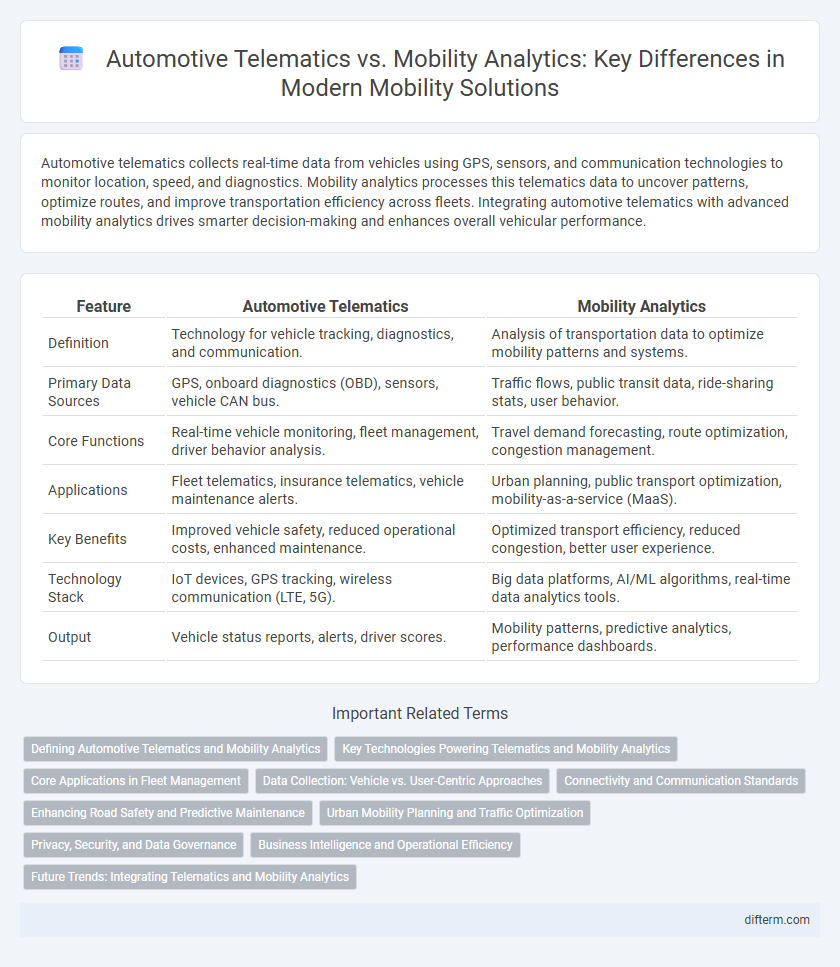Automotive telematics collects real-time data from vehicles using GPS, sensors, and communication technologies to monitor location, speed, and diagnostics. Mobility analytics processes this telematics data to uncover patterns, optimize routes, and improve transportation efficiency across fleets. Integrating automotive telematics with advanced mobility analytics drives smarter decision-making and enhances overall vehicular performance.
Table of Comparison
| Feature | Automotive Telematics | Mobility Analytics |
|---|---|---|
| Definition | Technology for vehicle tracking, diagnostics, and communication. | Analysis of transportation data to optimize mobility patterns and systems. |
| Primary Data Sources | GPS, onboard diagnostics (OBD), sensors, vehicle CAN bus. | Traffic flows, public transit data, ride-sharing stats, user behavior. |
| Core Functions | Real-time vehicle monitoring, fleet management, driver behavior analysis. | Travel demand forecasting, route optimization, congestion management. |
| Applications | Fleet telematics, insurance telematics, vehicle maintenance alerts. | Urban planning, public transport optimization, mobility-as-a-service (MaaS). |
| Key Benefits | Improved vehicle safety, reduced operational costs, enhanced maintenance. | Optimized transport efficiency, reduced congestion, better user experience. |
| Technology Stack | IoT devices, GPS tracking, wireless communication (LTE, 5G). | Big data platforms, AI/ML algorithms, real-time data analytics tools. |
| Output | Vehicle status reports, alerts, driver scores. | Mobility patterns, predictive analytics, performance dashboards. |
Defining Automotive Telematics and Mobility Analytics
Automotive telematics integrates GPS tracking, vehicle diagnostics, and communication systems to enable real-time monitoring and management of vehicles. Mobility analytics involves the collection and analysis of transportation data, such as traffic patterns and user behavior, to optimize mobility services and infrastructure planning. While telematics focuses on vehicle-specific data, mobility analytics provides broader insights into transportation networks and user mobility trends.
Key Technologies Powering Telematics and Mobility Analytics
Automotive telematics relies heavily on GPS technology, onboard diagnostics (OBD), and cellular communication to collect real-time vehicle data for navigation, safety, and performance monitoring. Mobility analytics utilize big data platforms, machine learning algorithms, and cloud computing to analyze traffic patterns, optimize transportation networks, and enhance urban mobility solutions. Advanced sensor integration and IoT connectivity form the core technologies driving innovation in both telematics and mobility analytics, transforming raw data into actionable insights for smarter mobility management.
Core Applications in Fleet Management
Automotive telematics primarily focuses on real-time vehicle tracking, diagnostics, and driver behavior monitoring to enhance operational efficiency and safety in fleet management. Mobility analytics leverages big data and predictive algorithms to optimize route planning, fuel consumption, and maintenance scheduling, driving cost reductions and improved asset utilization. Integrating telematics data with advanced analytics provides fleet managers actionable insights for strategic decision-making and enhanced service delivery.
Data Collection: Vehicle vs. User-Centric Approaches
Automotive telematics emphasizes vehicle-centric data collection, capturing real-time information such as GPS location, engine diagnostics, and driving behavior to optimize fleet management and vehicle maintenance. Mobility analytics adopts a user-centric approach, aggregating data from personal devices, ride-sharing apps, and public transit usage to understand travel patterns and improve urban mobility solutions. Both methodologies leverage big data and IoT technologies but differ fundamentally in their focus on either vehicle performance or user behavior insights.
Connectivity and Communication Standards
Automotive telematics leverages connectivity through standards like LTE, 5G, and Dedicated Short-Range Communications (DSRC) to enable real-time vehicle tracking, diagnostics, and emergency response. Mobility analytics relies on data collected via these communication standards to analyze traffic patterns, optimize route planning, and enhance transportation infrastructure efficiency. The integration of advanced V2X (Vehicle-to-Everything) communication protocols further bridges telematics data with mobility analytics for smarter, connected mobility ecosystems.
Enhancing Road Safety and Predictive Maintenance
Automotive telematics integrates GPS, vehicle diagnostics, and real-time data transmission to monitor driving behavior and vehicle health, significantly enhancing road safety by enabling immediate alerts and accident prevention measures. Mobility analytics processes vast datasets from connected vehicles and infrastructure to identify patterns, predict maintenance needs, and optimize traffic flow, reducing breakdowns and improving fleet efficiency. Combining telematics with advanced mobility analytics delivers predictive maintenance that minimizes downtime and supports proactive safety interventions, crucial for smarter transportation systems.
Urban Mobility Planning and Traffic Optimization
Automotive telematics provides real-time vehicle data such as location, speed, and engine diagnostics, enhancing fleet management and driver safety in urban environments. Mobility analytics leverages this telematics data combined with traffic flow patterns, public transit usage, and pedestrian movements to optimize traffic signals and reduce congestion. Integrating automotive telematics with mobility analytics enables smarter urban mobility planning by improving route efficiency and supporting sustainable transportation infrastructure development.
Privacy, Security, and Data Governance
Automotive telematics involves real-time data collection from vehicles, raising critical privacy concerns due to the potential exposure of sensitive location and behavioral information. Mobility analytics leverages aggregated and anonymized data to optimize transportation systems while ensuring compliance with stringent data governance frameworks that prioritize user consent and data minimization. Robust security protocols, including encryption and access controls, are essential to protect telematics data against unauthorized access and cyber threats in both domains.
Business Intelligence and Operational Efficiency
Automotive telematics integrates real-time vehicle data, GPS tracking, and diagnostic information to enhance fleet management and operational efficiency by reducing downtime and optimizing routes. Mobility analytics leverages big data and advanced BI tools to analyze travel patterns, user behavior, and transportation system performance, driving strategic decision-making and improving service delivery. Combining telematics data with mobility analytics platforms provides businesses with a comprehensive view, enabling predictive maintenance, cost reduction, and elevated customer experience.
Future Trends: Integrating Telematics and Mobility Analytics
Automotive telematics and mobility analytics are converging to create smarter transportation systems by integrating real-time vehicle data with advanced analytics for enhanced route optimization and predictive maintenance. Future trends emphasize the deployment of AI-driven telematics platforms that leverage big data from connected vehicles and infrastructure to improve traffic management and reduce emissions. This integration supports autonomous driving advancements and personalized mobility services, enabling seamless, efficient, and sustainable urban mobility ecosystems.
Automotive telematics vs Mobility analytics Infographic

 difterm.com
difterm.com